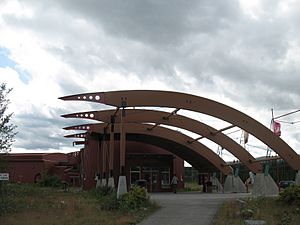Yukon Beringia Interpretive Centre facts for kids

Entrance to the Yukon Beringia Interpretive Centre
|
|
| Location | Alaska Highway, Whitehorse, Yukon, Canada |
|---|---|
| Type | Human and natural history museum |
| Architect | Masnasc Isaac |
| Owner | Government of Yukon |
The Yukon Beringia Interpretive Centre is a cool place in Whitehorse, Yukon, Canada. It opened in 1997. This centre teaches visitors all about Beringia. Beringia was a huge land bridge that connected Asia and North America a long, long time ago.
Imagine a giant piece of land, about 3,200 kilometers long! It stretched from the Kolyma River in Siberia to the Mackenzie River in Canada. This area was special because it didn't get covered by glaciers during the Pleistocene Ice Age. This was because it had very little snowfall. Beringia was super important for archeologists and paleontologists. It was like a highway for many animals and even early humans. They used it to travel between Asia and the Americas. A Swedish scientist named Eric Hultén first used the name "Beringia" in 1937.
During the Ice Age, many animals moved across Beringia. Some traveled east, like mastodons, mammoths, deer, bison, sheep, and muskoxen. Others went west, such as horses and camels. Even tiny animals like lemmings and voles moved back and forth many times!
Contents
Discovering Ancient Life in Beringia
Scientists at the Yukon Beringia Interpretive Centre do a lot of exciting research. They study ancient plants and animals found in the Yukon. This helps us understand what Beringia was like thousands of years ago.
Fossils and Ancient Plants
Recent research has looked at ancient plants found near the Bluefish Caves. They also study the homes of ground squirrels, called Spermophilus parryii. These squirrels collect plant pieces in their homes, which become "middens." These middens are like time capsules, showing what plants grew long ago.
Scientists also explore areas like the Klondike gold fields and the Old Crow region. These places have given us amazing fossils. Some of these fossils belong to animals that are very rare to find from the Ice Age.
Giant Ice Age Animals
Imagine these incredible creatures that once roamed Beringia:
- Giant beaver (Castoroides ohioensis): Much bigger than today's beavers!
- Broad-fronted moose (Cervalces latifrons): A huge type of moose.
- Western camel (Camelops hesternus): An ancient camel that lived in North America.
- American mastodon (Mammut americanum): A large, elephant-like animal.
- Scimitar cat (Homotherium serum): A powerful cat with long, curved teeth.
- Short-faced bear (Arctodus simus): One of the largest bears that ever lived.
Scientists use a method called radiocarbon dating to find out how old these fossils are. This helps them understand when these animals lived.
Ancient Fish Discoveries
Researchers have also found fish fossils. Some whitefish fossils, about 2 million years old, were found in the Bluefish Basin. These are from a type of giant beaver called Coregonus beringiaensis.
Who Runs the Centre?
The Yukon Beringia Interpretive Centre is managed by the Department of Tourism and Culture of the Government of Yukon. This means the government helps make sure the centre can keep teaching people about Beringia.
Working with Other Museums
The Yukon Beringia Interpretive Centre works with other groups. It is connected to the Alliance of Natural Museums of Natural History of Canada [1]. It also works with the Virtual Museum of Canada. This helps them share their amazing discoveries with even more people!

